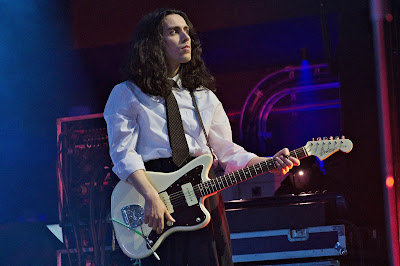Look a little deeper than teenage alliance, though, and the 1980s are revealed, not just as good but as revolutionary. An extinction level event in music, as significant as the transistor radio and the electric guitar.
Consider yourself as a budding musician in the 1960s, a decade which spawned countless iconic musical acts. If you had an ear for a tune and you fancied being a pop star, you would have to learn to play an instrument. You would have to find some friends who could also play instruments. You would have to learn to read and write music. You would need a rehearsal space with very forgiving neighbours, or your uncle would let you use his cold, rat infested warehouse at the weekends.
Gary Daly of 80s electronic band China Crisis tells the story of how his mum got him a synthesiser from the Great Universal catalogue which he and Eddie Lundun would play with in their bedrooms. “Hey! That sounds like The Human League!”, he recalls.
The electronic synthesiser democratised the production of music. You no longer needed a studio or even any musical ability. Once the technology became mass produced, you could buy an early Yamaha, Korg or Roland and a multi-track tape recorder and instantly transform your bedroom into a recording studio capable of producing any sound from any instrument. For very, very little money you could buy a Bontempi or a Casio organ with its built in instruments and rhythms. You had become a solo orchestra. You no longer needed Polydor or EMI or Virgin. As technology evolved, you could produce and record your own music, you could distribute it yourself via home made tapes, CDs and then the Internet and you had instant access to a world which your parents could scarcely have dreamed of. Almost overnight, music-makers were unconstrained by both conventional musical knowledge and the whims and preconceptions of record label executives.
There were two routes that musicians took with synthesisers, either try to make them sound like something that already existed or to fiddle with the knobs and see what it would do. The latter approach gave rise to an experimental ‘new wave’ sound, characterised by noises that littered the soundscape, creating something which no traditional musician could have done.
At the forefront of this new wave of electronic synth music were bands such as the aforementioned Human League, Kraftwerk, Ultravox, Talking Heads, Gary Numan, Blancmange, Depeche Mode and of course, Orchestral Manoeuvres in the Dark, aka OMD.
OMD, comprising Andy McCluskey and Paul Humphreys, first got together in 1978 with a Korg M-500 Micro Preset synthesiser, acquired just like the one used by China Crisis, through McCluskey’s mother’s mail-order catalogue for £7.76 a week, paid over 36 weeks - around the price of a washing machine or colour TV. Together with a TEAC 4-track tape-recorder, OMD started playing live gigs around Liverpool and were quickly picked up for a seven album recording deal, such was their luck at hitting the leading edge of the new wave music with a sound that was in high demand.
46 years later, OMD are still touring and this latest road trip takes them across the UK, South Africa, Canada and USA up to autumn 2024 as they launch their latest studio album, ‘Bauhaus Staircase’.
Supported on this tour by Walt Disco, the opening was a fittingly high energy, 80s fusion blend of Sparks, Visage and even A Flock of Seagulls which may or may not have been familiar to the more mature audience but which dovetailed perfectly into the energy and style of OMD’s main show.
OMD’s arrival was announced by a largely instrumental track, ‘Evolution’, which literally set the stage by showcasing the enormous LED panels which formed the backdrop to the stage with a mesmerising and ever-changing light show which contrasted with McCluskey’s typically high energy performance which involves an amount of running and arm waving which would put musicians half or even a third of his age to shame. The experimental, boundary-pushing nature of the music together with the awe-inspiring lighting and visuals created a landscape which showcased OMD as one of the real masters of the ‘new’ electronic sound.
Whizzing through an anthology of 24 songs in total, OMD mixed up fan favourites, tracks from the new album and chart hits with the only break in pace coming when the band paused to allow medics to aid a struggling fan at the front of the arena.
The combination of songs ranged from high concept art to mainstream pop with plenty of variety in between. For the 1986 hit ‘Forever Live and Die’, McCluskey and Humphreys swapped places, with Humphrey’s gentler presentation changing the pace and tone of the show and continuing into OMD’s highest charting song, the hauntingly beautiful ‘Souvenir’.
Finishing with probably their best known hit, and certainly the one which pushed them into the mainstream, ‘Enola Gay’, none of the 3,000-odd fans believed that this was the finale and they were right, three more songs arrived in an encore which ended where it all began, the first release in 1979 of ‘Electricity’, a fitting conclusion to a night which was electrifying from start to finish.




